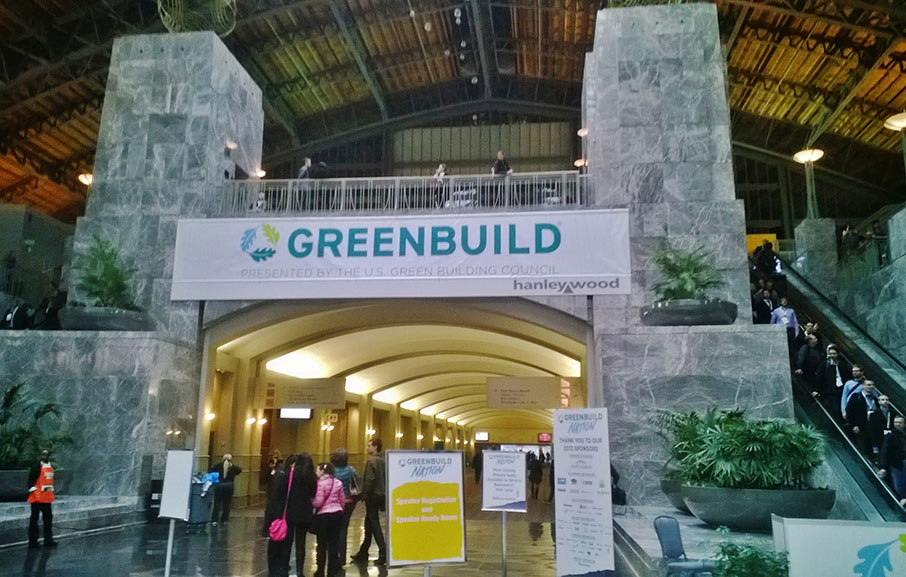 Once a year, for about a week, all eyes in green building culture turn towards a single focus - it’s been San Francisco, it’s been Toronto, Chicago, Phoenix, and Boston. Every year it is a new city for Greenbuild, the world’s largest conference and exposition dedicated to the green building industry. This year, its 20th year running, it was Philadelphia. I had the pleasure of representing Bialosky + Partners Architects at Greenbuild 2013 this past November. The international convention and expo hosted approximately 30,000 attendees from 90 different countries and touted speakers as varied and prestigious as Rich Ferizzi, President & CEO of the USGBC; Michael Nutter, Mayor of Philadelphia; Nate Silver, author of The Signal and the Noise; and the keynote address was given by former Secretary of State and former First Lady, Hillary Rodham Clinton.
Once a year, for about a week, all eyes in green building culture turn towards a single focus - it’s been San Francisco, it’s been Toronto, Chicago, Phoenix, and Boston. Every year it is a new city for Greenbuild, the world’s largest conference and exposition dedicated to the green building industry. This year, its 20th year running, it was Philadelphia. I had the pleasure of representing Bialosky + Partners Architects at Greenbuild 2013 this past November. The international convention and expo hosted approximately 30,000 attendees from 90 different countries and touted speakers as varied and prestigious as Rich Ferizzi, President & CEO of the USGBC; Michael Nutter, Mayor of Philadelphia; Nate Silver, author of The Signal and the Noise; and the keynote address was given by former Secretary of State and former First Lady, Hillary Rodham Clinton.  Greenbuild is more than just a world-class convention. It is also a networking smorgasbord and showcase of all things sustainable. This year the expo hall was packed with over 800 exhibitors of sustainable products and services. Huge multinational corporations displayed their full suite of green products right next to small startup companies rolling-out their newest gadget or software to a captive, and captivated, audience.
Greenbuild is more than just a world-class convention. It is also a networking smorgasbord and showcase of all things sustainable. This year the expo hall was packed with over 800 exhibitors of sustainable products and services. Huge multinational corporations displayed their full suite of green products right next to small startup companies rolling-out their newest gadget or software to a captive, and captivated, audience.  Multiple parallel tracks of educational sessions provided a plethora of learning opportunities. Lectures ranged from changes in the newest version of ASHRAE 90.1 to low energy lighting strategies, and from net-zero design to insights on the commissioning of existing buildings. Some of the most highly anticipated and well attended sessions dealt with LEED v4, which was officially introduced at Greenbuild 2013. It’s a lot to wrap your head around. Throughout the entire convention, a simple but powerful idea kept presenting itself to me… this is not an isolated, short-lived movement. This is not a passing fashion. This is not a fad.
Multiple parallel tracks of educational sessions provided a plethora of learning opportunities. Lectures ranged from changes in the newest version of ASHRAE 90.1 to low energy lighting strategies, and from net-zero design to insights on the commissioning of existing buildings. Some of the most highly anticipated and well attended sessions dealt with LEED v4, which was officially introduced at Greenbuild 2013. It’s a lot to wrap your head around. Throughout the entire convention, a simple but powerful idea kept presenting itself to me… this is not an isolated, short-lived movement. This is not a passing fashion. This is not a fad.  Whether the adjectives used to describe it are “earth-friendly”, or “sustainable”, or “eco”, or “green”… the fact is, the world is changing. Greenbuild is one time a year when those people keeping track congregate and try to direct that change to be something manageable, and positive, and fun. Another successful year… now on to 2014… this time it’s New Orleans.
Whether the adjectives used to describe it are “earth-friendly”, or “sustainable”, or “eco”, or “green”… the fact is, the world is changing. Greenbuild is one time a year when those people keeping track congregate and try to direct that change to be something manageable, and positive, and fun. Another successful year… now on to 2014… this time it’s New Orleans.
